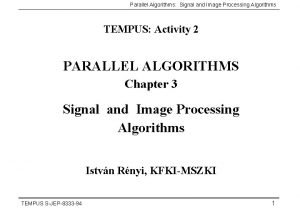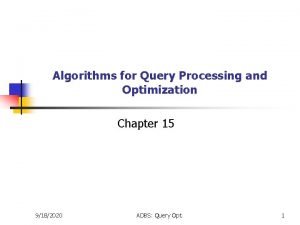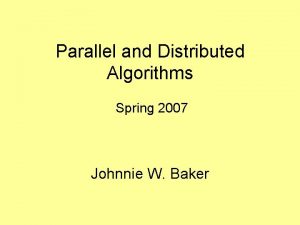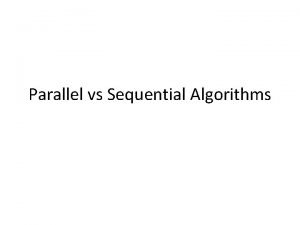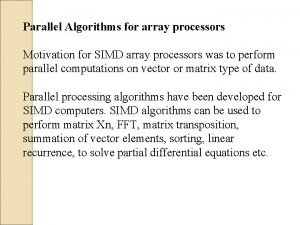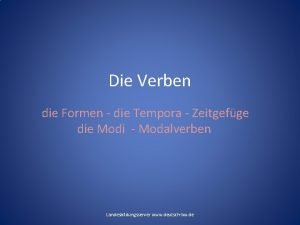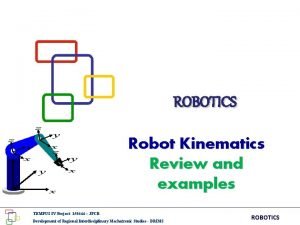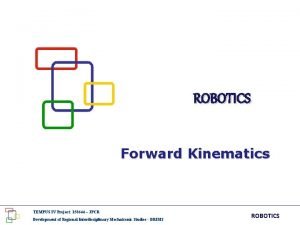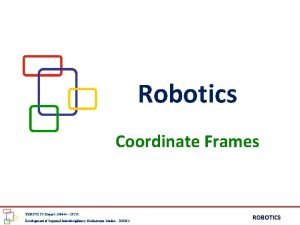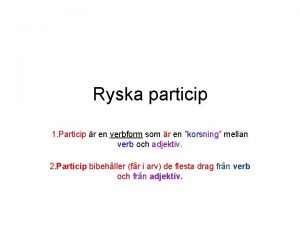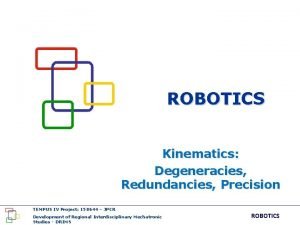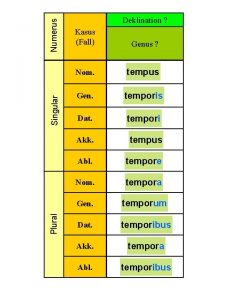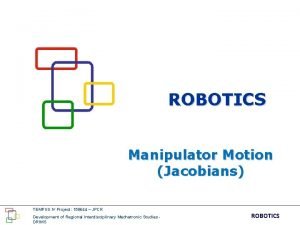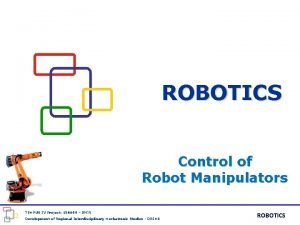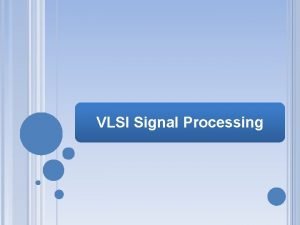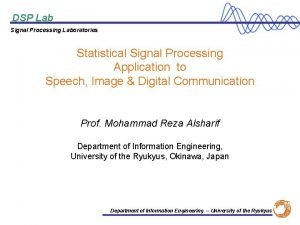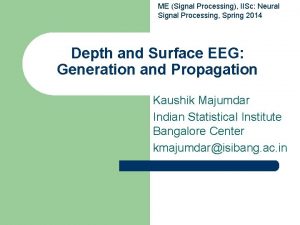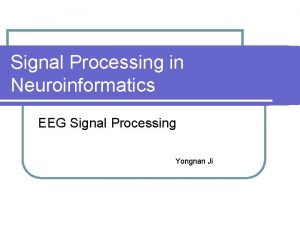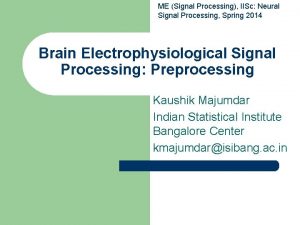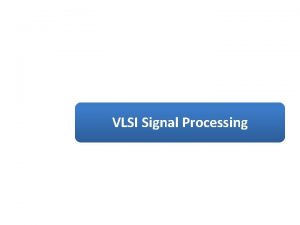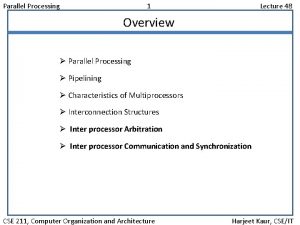Parallel Algorithms Signal and Image Processing Algorithms TEMPUS





















































- Slides: 53

Parallel Algorithms: Signal and Image Processing Algorithms TEMPUS: Activity 2 PARALLEL ALGORITHMS Chapter 3 Signal and Image Processing Algorithms István Rényi, KFKI-MSZKI TEMPUS S-JEP-8333 -94 1

Parallel Algorithms: Signal and Image Processing Algorithms 1 Introduction Before engaging in spec. purpose array processor architecture and implementation, the properties and classifications of algorithms must be understood. Algorithm is a set of rules for solving a problem in a finite number of steps • Matrix Operations • Basic DSP Operations • Image Processing Algorithms • Others (searching, geometrical, polynomial, etc. algorithms) TEMPUS S-JEP-8333 -94 2

Parallel Algorithms: Signal and Image Processing Algorithms 1 Introduction - continued Two important aspects of algorithmic study: application domains and computation counts Examples: TEMPUS S-JEP-8333 -94 3

Parallel Algorithms: Signal and Image Processing Algorithms 1 Introduction - continued Large amounts of data + tremendous computation requirement, increasing demands of speed and performance in DSP => => need for revolutionary supercomputing technology Usually multiple operations are performed on a single data item on a recursive and regular manner. TEMPUS S-JEP-8333 -94 4

Parallel Algorithms: Signal and Image Processing Algorithms 2 Matrix Algorithms Basic Matrix Operations • Inner product and TEMPUS S-JEP-8333 -94 5

Parallel Algorithms: Signal and Image Processing Algorithms 2 Matrix Algorithms - continued • Outer product • Matrix-Vector Multiplication v = Au (A is of size n x m, u is an m-element, v is an n-element vector) TEMPUS S-JEP-8333 -94 6

Parallel Algorithms: Signal and Image Processing Algorithms 2 Matrix Algorithms - continued • Matrix Multiplication C=AB (A is m x n, B is n x p, C becomes m x p) • Solving Linear Systems n lin. equations, n unknowns. Find n x 1 vector x: Ax= y x = A -1 y number of computations for A-1 is high, procedure unstable. Triangularize A to get upper triangular matrix A’ A’ x = y ’ back substitution provides solution x TEMPUS S-JEP-8333 -94 7

Parallel Algorithms: Signal and Image Processing Algorithms 2 Matrix Algorithms - continued Matrix triangularization • Gaussian elimination • LU decomposition • QR decomposition: orthogonal transform, e. g. Given’s rotation (GR) A=QR upper triangular M M with orthonormal columns A sequence of GR plane rotations annihilates A’s subdiagonal elements, and invertible A becomes an matrix, R. TEMPUS S-JEP-8333 -94 8

Parallel Algorithms: Signal and Image Processing Algorithms 2 Matrix Algorithms - continued QT A = R QT = Q(N-1) Q(N-2). . . Q(1) and Q(p) = Q(p, p) Q(p+1, p). . . Q(N-1, p) where Q(pq) is the GR operator to nullify matrix element at the (q+1)st row, pth column, and has the following form: TEMPUS S-JEP-8333 -94 9

Parallel Algorithms: Signal and Image Processing Algorithms 2 Matrix Algorithms - continued col. p+1 row q+1 where = tan-1 [aq+1, p / aq, p ] TEMPUS S-JEP-8333 -94 10

Parallel Algorithms: Signal and Image Processing Algorithms 2 Matrix Algorithms - continued A’ = Q(q, p) then becomes: a’q, k = aq, k cos aq+1, k sin a’q+1, k = - aq, k sin aq+1, k cos a’jk = ajk if j q, q + 1 for all k = 1, . . . , N. Back substitution A’ x = y’ x can be found heuristically. Example: Thus TEMPUS S-JEP-8333 -94 11

Parallel Algorithms: Signal and Image Processing Algorithms 2 Matrix Algorithms - continued • Iterative Methods When large, sparse matrices (e. g. 105 x 105 ) are involved g= Hf representing phys. measurements Splitting: A=S+T initial guess: x 0 iteration: S xk+1 = -Txk + y Sequence of vectors xk+1 are expected to converge to x. TEMPUS S-JEP-8333 -94 12

Parallel Algorithms: Signal and Image Processing Algorithms 2 Matrix Algorithms - continued • Eigenvalue - Decomposition A is of size n x n. If there exists e such that A e = e is called eigenvalue, e is eigenvector. obtained by solving the |A - 0 characteristic eqn. For distinct eigenvalues: A E = E E is invertible, and hence A = E E-1 n x n normal matrix A, i. e. AH A = A AH can be factored A = U UT U is n x n unitary matrix. Spectral decomposition, KL transform. TEMPUS S-JEP-8333 -94 13

Parallel Algorithms: Signal and Image Processing Algorithms 2 Matrix Algorithms - continued • Singular Value Decomposition (SVD) Useful in —image coding —image enhancement —image reconstruction, restoration - based on the pseudoinverse A = Q 1 Q 2 T where Q 1 : m x m unitary M Q 2 : n x n unitary M where D = diag( , , . . . , r), r, > 0, r is the rank of A TEMPUS S-JEP-8333 -94 14

Parallel Algorithms: Signal and Image Processing Algorithms 2 Matrix Algorithms - continued SVD can be rewritten: A = Q 1 Q 2 T = ri= ui vi. T whereui is column vector of Q 1, vi is column vector of Q 2 The singular values of A: , , . . . , r are square roots of the eigenvalues of AT A (or A AT) The column vectors of Q 1, Q 2 are the singular vectors of A, and are eigenvectors of AT A (or A AT). SVD also used to — solve the least squares problem — determine the rank of a matrix — find good low-rank approx. to the original matrix TEMPUS S-JEP-8333 -94 15

Parallel Algorithms: Signal and Image Processing Algorithms 2 Matrix Algorithms - continued • Solving Least Squares Problems Useful in control, communication, DSP — equalization — spectral analysis — adaptive arrays — digital speech processing Problem formulation: Given A , an n x p (n > p, rank = p) observation matrix and y, an n-element desired data vector Find w, a p-element weight vector, which minimizes Euclidean norm of residual vector, e. e=y-Aw TEMPUS S-JEP-8333 -94 16

Parallel Algorithms: Signal and Image Processing Algorithms 2 Matrix Algorithms - continued Unconstrained Least Squares Algorithm Q e = Q y - [Q A ] = y’ - A’ w orthonormal M i. e. A’ reduced to upper triangular M represented by To minimize Euclidean norm of y’ - A’ w, wopt is obtained (w has no influence on the lower parts of the difference). Therefore R wopt = y’ wopt is obtained by back-substitution ( R is TEMPUS S-JEP-8333 -94 ) 17

Parallel Algorithms: Signal and Image Processing Algorithms 3 Digital Signal Processing Algorithms • Discrete Time Systems and the Z-transform Continuous - discrete time signals (sampled continuous signal) Linear Time Invariant (LTI) systems characterized by h(n), the response to sampling sequence, (n). This is the convolution operation. Z-transform -- definition: z is a complex number in a region of the z-plane. TEMPUS S-JEP-8333 -94 18

Parallel Algorithms: Signal and Image Processing Algorithms 3 DSP Algorithms - continued Useful properties: • Convolution where n = 0, 1, 2, . . . , 2 N-2 u(n). . . input sequence, w(n). . . impulse response of digital filter y(n). . . processed (filtered) signal TEMPUS S-JEP-8333 -94 19

Parallel Algorithms: Signal and Image Processing Algorithms 3 DSP Algorithms - continued Computation Using transform (e. g. FFT) method, order of computation reduced from O( N 2 ) to O( N log N ). Recursive equations yjk = yjk-1 + uk wj-k k = 0, 1, . . . , j when j = 0, 1, . . . , N-1 and k = j - N + 1, j - N + 2, . . . , N - 1, when j = N, N + 1, . . . , 2 N-2 • Correlation TEMPUS S-JEP-8333 -94 20

Parallel Algorithms: Signal and Image Processing Algorithms 3 DSP Algorithms - continued • Digital FIR and IIR Filters H(e j ) = | H(e j )| e j ( ) | H(e j )| is the magnitude, ( ) is the phase response. — Finite Impulse Response (FIR) filters — Infinite Impulse Response (IIR) Representation: pth order difference eqn. — Moving Average Filter — Autoregressive Moving Average Filter TEMPUS S-JEP-8333 -94 21

Parallel Algorithms: Signal and Image Processing Algorithms 3 DSP Algorithms - continued • Linear Phase Filter Impulse response of FIR filter: h(n) = h(N - 1 - n), n = 0, 1, . . . , N - 1 Half number of multiplications can be used. For N odd: TEMPUS S-JEP-8333 -94 22

Parallel Algorithms: Signal and Image Processing Algorithms 3 DSP Algorithms - continued • Discrete Fourier Transform (DFT) The DFT of finite lengths sequence x(n) is: where k = 0, 1, 2, . . . , N - 1, and WN = e-j 2 /N. Efficiently computed using FFT. Properties: — Obtained by uniformly sampling the FFT of the sequence at TEMPUS S-JEP-8333 -94 23

Parallel Algorithms: Signal and Image Processing Algorithms 3 DSP Algorithms - continued Inverse DFT: — Multiplying the DFTs of two N-point sequences is equivalent to the circular convolution of the two sequences: X 1(k) = DFT of [x 1(n)] X 2(k) = DFT of [x 2(n)], then X 3(k) = X 1 (k) X 2(k), is the DFT of [x 3(n)] where and n = 0, 1, . . . , N -1 TEMPUS S-JEP-8333 -94 24

Parallel Algorithms: Signal and Image Processing Algorithms 3 DSP Algorithms - continued • Fast Fourier Transform (FFT) DFT computational complexity (direct method): each x(n)Wnk requires 1 complex multiplication X(k) {k = 0, 1, . . . , N -1} requires N 2 complex mult. + N(N-1) addn. DFT computational complexity using FFT (N = 2 m case): Utilizing symmetry + periodicity of W nk , op. count reduced from N 2 to N log 2 N If one complex multiplication takes sec: TEMPUS S-JEP-8333 -94 25

Parallel Algorithms: Signal and Image Processing Algorithms 3 DSP Algorithms - continued — Decimation in time (DIT) algorithm /discussed here/ — Decimation in frequency (DIF) DIT FFT TEMPUS S-JEP-8333 -94 26

Parallel Algorithms: Signal and Image Processing Algorithms 3 DSP Algorithms - continued obtained via N/2 -point FFT - N-point FFT: via combining two N/2 -point FFTs - Applying this decomposition recursively, 2 -point FFTs could be used. FFT computation consists of a sequence of “butterfly”operations, each consisting 1 addition, 1 subtraction and 1 multiplication. TEMPUS S-JEP-8333 -94 27

Parallel Algorithms: Signal and Image Processing Algorithms 3 DSP Algorithms - continued Linear convolution using FFT (1) Append zeros to the two sequences of lengths N and M, to make them of lengths an integer power of two that is larger than or equal to M+N-1. (2) Apply FFT to both zero appended sequences (3) Multiply the two transformed domain sequences (4) Apply inverse FFT to the new multiplied sequence TEMPUS S-JEP-8333 -94 28

Parallel Algorithms: Signal and Image Processing Algorithms 3 DSP Algorithms - continued • Discrete Walsh-Hadamard Transform (WHT) Hadamard matrix: a square array of +1’s and -1’s, an orthogonal M. iterative definition: Size eight Hadamard matrix: Input data vector x of lengths N (N=2 n). Output y = HN x TEMPUS S-JEP-8333 -94 29

Parallel Algorithms: Signal and Image Processing Algorithms 4 Image Processing Algorithms IP operations , which are extended forms of their 1 D counterparts: No of computations high -> transform methods are used TEMPUS S-JEP-8333 -94 30

Parallel Algorithms: Signal and Image Processing Algorithms 4 Image Processing Algorithms - continued TEMPUS S-JEP-8333 -94 31

Parallel Algorithms: Signal and Image Processing Algorithms 4 Image Processing Algorithms - continued TEMPUS S-JEP-8333 -94 32

Parallel Algorithms: Signal and Image Processing Algorithms 5 Advanced Algorithms and Applications • Divide-and-Conquer Technique 1 st level 2 nd level subproblem subproblem 2 nd level subproblem TEMPUS S-JEP-8333 -94 subproblem 33

Parallel Algorithms: Signal and Image Processing Algorithms 5 Advanced Algorithms - continued — Subproblems formulated like smaller versions of original — same routine used repeatedly at different levels — top down, recursive approach Examples: — sorting — FFT algorithm Important research topic — design of interconnection networks (See FFT in “VLSI Array Algorithms” later) TEMPUS S-JEP-8333 -94 34

Parallel Algorithms: Signal and Image Processing Algorithms 5 Advanced Algorithms - continued • Dynamic Programming Method — Used in optimization problems to minimize/maximize a function — Bottom up procedure Results of a stage used to solve the problems of the stage above — One stage - one subproblem to solve — Solutions to subproblems linked by recurrence relation important in mapping algorithms to arrays with local interconnect Examples: — Shortest path problem in a graph — Minimum cost path finding — Dynamic Time Warping (for speech processing) TEMPUS S-JEP-8333 -94 35

Parallel Algorithms: Signal and Image Processing Algorithms 5 Advanced Algorithms - continued • Relaxation Technique — Iterative approach, making updating in parallel — Each iteration uses data from most recent updating (in most cases neighboring data elements) — Initial choices successively refined — Very suitable for array processors, because it is order independent Updating at each data point executed in parallel Examples: — Image reconstruction — Restoration from blurring — Partial differential equations TEMPUS S-JEP-8333 -94 36

Parallel Algorithms: Signal and Image Processing Algorithms 5 Advanced Algorithms - continued • Stochastic Relaxation (Simulated Annealing) Problem in optimization approaches: solution may only be locally and not globally optimal — Energy function, state transition probability function introduced — Facilitates getting out of the trap of local optimum — Introduces trap flattening - based on stochastic decision temporarily accepting worse solutions — Probability of moving out of global optimum is low Examples: — Image restoration and reconstruction — Optimization — Code design for communication systems — Artificial intelligence TEMPUS S-JEP-8333 -94 37

Parallel Algorithms: Signal and Image Processing Algorithms 5 Advanced Algorithms - continued • Associative Retrieval Features: — — — Recognition from partial information Remarkable error correction capabilities Based on Content Addressable Memory (CAM) Performs parallel search and parallel comparison operations Closely related to human brain functions Examples: — Storage, retrieval of rapidly changing database — image processing — computer vision — radar signal tracking — artificial intelligence TEMPUS S-JEP-8333 -94 38

Parallel Algorithms: Signal and Image Processing Algorithms 5 Advanced Algorithms - continued Hopfield Networks — Uses two-state ‘neurons’. In state i, outputs are: Vi 0 , Vi 1. — Inputs from a) external source Ii, and b) from other neurons — Energy function given by: where Tij: interconnection strength from neuron i to j — Difference energy function between two different levels: for E < 0, the unit turns on, for E > 0, the unit turns off — The Hopfield model behaves as a CAM • Local minimum corresponds to stored target pattern. • Starting close to a stable state, it would converge to that state TEMPUS S-JEP-8333 -94 39

Parallel Algorithms: Signal and Image Processing Algorithms 5 Advanced Algorithms - continued Energy function starting point p 4 p 2 p 1 trapped point global minimum p 3 states The original Hopfield model behaves as an associative memory. The local minimum (p 1, p 2, p 3, p 4) correspond to stored target patterns TEMPUS S-JEP-8333 -94 40

Parallel Algorithms: Signal and Image Processing Algorithms 6 VLSI Array Algorithms Array algorithm: A set of rules for solving a problem in a finite number of steps by a multiple number of interconnected processors — Concurrency achieved by decomposing the problem • into independent subtasks executable in parallel • into dependent subtasks executable in pipelined fashion — Communication - most crucial regarding efficiency • a scheme of moving data among PEs • VLSI technology constrains recursive and locally dependent algorithms — Algorithm design • Understanding problem specification • Mathematical / algorithmic analysis • Dependence graph - effective tool • New algorithmic design methodologies to exploit potential concurrency TEMPUS S-JEP-8333 -94 41

Parallel Algorithms: Signal and Image Processing Algorithms 6 VLSI Array Algorithms - continued • Algorithm Design Criteria for VLSI Array Processors The effectiveness of mapping algorithm onto an array heavily depends on the way the algorithm is decomposed. • On sequential machines complexity depends on computation count and storage requirement • In array proc. environment overhead is non uniform, computation count is no longer an effective measure of performance — Area-Time Complexity Theory Complexity depends on computation time (T) and chip area (A) Complexity measure is AT 2 - not emphasized here, not recognized as a good design criteria Cost effectiveness measure f(A, T) can be tailored to special needs TEMPUS S-JEP-8333 -94 42

Parallel Algorithms: Signal and Image Processing Algorithms 6 VLSI Array Algorithms - continued —Design Criteria for VLSI Array Algorithms New criteria needed to determine algorithm efficiency to include • stringent communication problems associated with VLSI technology • communication costs • parallelism and pipelining rate Criteria should comprise computation, communication, memory and I/O Their key aspects are: m m Maximum parallelism which is exploitable by the computing array Maximum pipelineability For regular and locally connected networks Unpredictable data dependency may jeopardize efficiency Iterative methods, dynamic, data-dependent branching are less well suited to pipelined architectures TEMPUS S-JEP-8333 -94 43

Parallel Algorithms: Signal and Image Processing Algorithms 6 VLSI Array Algorithms - continued m m Balance among computations, communications and memory Critical to the effectiveness of array computing Pipelining is suitable for balancing computations and I/O Trade-off between computation and communication Key issues • • • m local / global static / dynamic data dependent / data independent Trade-off between interconnection cost and thruput is to be maximized Numerical performance, quantization effects Numerical behavior depends on word lengths and algorithm Additional computation may be necessary to improve precision Heavily ‘problem dependent’ issue - no general rule TEMPUS S-JEP-8333 -94 44

Parallel Algorithms: Signal and Image Processing Algorithms 6 VLSI Array Algorithms - continued • Locally and Globally Recursive Algorithms Common features of signal / image processing algorithms: • intensive computation • matrix operations • localized or perfect shuffle operations In an interconnected network each PE should know when, where and how to send / fetch data. where? In locally recursive algorithms data movements are confined to nearest neighbor PEs. Here locally interconnected network is OK when? In globally synchronous schemes timing controlled by a sequence of ‘beats’ (see systolic array) TEMPUS S-JEP-8333 -94 45

Parallel Algorithms: Signal and Image Processing Algorithms 6 VLSI Array Algorithms - continued —Local and Global Communications in Algorithms Concurrent processing performance critically depends on communication cost Each PE is assigned a location index Communication cost characterized by the distance between PEs Time index, spatial index - to show when and where computation takes place • Local type recursive algorithm: index separations are within a certain limit (E. g. matrix multiplication, convolution) • Global type recursive algorithm: recursion involves separated space indices. Calls for globally interconnected structures (E. g. FFT and sorting) TEMPUS S-JEP-8333 -94 46

Parallel Algorithms: Signal and Image Processing Algorithms 6 VLSI Array Algorithms - continued — Locally Recursive Algorithms • Majority of algorithms: localized operations, intensive computation • When mapped onto array structure only local communication required • Next subject (chapter) will be entirely devoted to these algorithms — Globally Recursive Algorithms: FFT example • Perfect shuffle in FFT requires global communication • (N/2)log 2 N butterfly operations needed • For each butterfly 4 real multiplications and 4 real additions needed • In single state configuration N/2 PEs and log 2 N time units needed TEMPUS S-JEP-8333 -94 47

Parallel Algorithms: Signal and Image Processing Algorithms 6 VLSI Array Algorithms - continued PE PE PE Array configuration for the FFT computation: Multistage Array TEMPUS S-JEP-8333 -94 48

Parallel Algorithms: Signal and Image Processing Algorithms 6 VLSI Array Algorithms - continued M-A M-A Array configuration for the FFT computation: Single-stage Array TEMPUS S-JEP-8333 -94 49

Parallel Algorithms: Signal and Image Processing Algorithms 6 VLSI Array Algorithms - continued Perfect Shuffle Permutation Single bit left shift of the binary representation of index x: x = { bn, , bn-1, . . . , b 1 } (x) = {bn-1, bn-2, , . . . , b 1, bn } Exchange permutation k (x) = { bn, , . . . , bk’, . . . , b 1 } where bk’ denotes the complement of the kth bit The next figure compares perfect shuffle permutation and exchange permutation networks TEMPUS S-JEP-8333 -94 50

Parallel Algorithms: Signal and Image Processing Algorithms 6 VLSI Array Algorithms - continued 000 000 000 001 001 001 010 010 010 011 011 011 100 100 100 101 101 101 110 110 110 111 111 (a) Perfect shuffle permutations, TEMPUS S-JEP-8333 -94 111 (b) Exchange permutations 51

Parallel Algorithms: Signal and Image Processing Algorithms 6 VLSI Array Algorithms - continued FFT via Shuffle-Exchange Network Interconnection network for in-place computation has to provide • exchange permutation ( (k)) • bit-reversal permutation ( ) For a 8 -point DIT FFT the interconnection network can be represented as [ (1)[ (2)[ (3)]]] apply (3) first, (2) next, etc. X(k) computed by separating x(k) into even and odd N/2 sequences n and k are represented by 3 -bit binary numbers: n = ( n 3 n 2 n 1) = 4 n 3 + 2 n 2 + n 1 k = ( k 3 k 2 k 1) = 4 k 3 + 2 k 2 + k 1 TEMPUS S-JEP-8333 -94 52

Parallel Algorithms: Signal and Image Processing Algorithms 6 VLSI Array Algorithms - continued Result: Due to in-place replacement (i. e. input and output data share storage) n 1 is replaced by k 3 , n 3 is replaced by k 1 , etc. x ( n 3 n 2 n 1 ) is stored in the array position X( k 1 k 2 k 3 ) i. e. to determine the position of x( n 3 n 2 n 1 ) in the input, bits of index n have to be reversed. TEMPUS S-JEP-8333 -94 53
 Parallel image processing algorithms
Parallel image processing algorithms Parallel processing vs concurrent processing
Parallel processing vs concurrent processing Neighborhood averaging in image processing
Neighborhood averaging in image processing Point processing in image processing example
Point processing in image processing example Histogram processing in digital image processing
Histogram processing in digital image processing Neighborhood processing in digital image processing
Neighborhood processing in digital image processing Point processing in image processing
Point processing in image processing Thinning and thickening in image processing example
Thinning and thickening in image processing example Image transform in digital image processing
Image transform in digital image processing Optimum notch filter in digital image processing
Optimum notch filter in digital image processing Fundamentals of image compression
Fundamentals of image compression Key stages in digital image processing
Key stages in digital image processing Variable length coding in digital image processing
Variable length coding in digital image processing Image sharpening in digital image processing
Image sharpening in digital image processing Geometric transformation in digital image processing
Geometric transformation in digital image processing Zooming and shrinking in digital image processing
Zooming and shrinking in digital image processing Walsh transform in digital image processing
Walsh transform in digital image processing Imtransform matlab
Imtransform matlab Image restoration in digital image processing
Image restoration in digital image processing Baseband signal and bandpass signal
Baseband signal and bandpass signal Baseband signal and bandpass signal
Baseband signal and bandpass signal Even odd signals
Even odd signals Algorithms for query processing and optimization
Algorithms for query processing and optimization Parallel and distributed algorithms
Parallel and distributed algorithms Digital signal as a composite analog signal
Digital signal as a composite analog signal Parallel vs sequential algorithms
Parallel vs sequential algorithms Simd parallel algorithms
Simd parallel algorithms Who of the following was not part of the bebop generation?
Who of the following was not part of the bebop generation? Vestibulum congue tempus
Vestibulum congue tempus Die tempora des verbs
Die tempora des verbs Direkten i indirekten govor
Direkten i indirekten govor Rebecca reichenbach
Rebecca reichenbach Ubi spectaculi tempus venit
Ubi spectaculi tempus venit Tempus novi sad
Tempus novi sad Tempus
Tempus Kinematics
Kinematics Tempus
Tempus Robotics right hand rule
Robotics right hand rule Perfekt tempus
Perfekt tempus Presens preteritum perfektum futurum
Presens preteritum perfektum futurum La tierra de la abundancia topico literario
La tierra de la abundancia topico literario Who made
Who made Vestibulum congue tempus
Vestibulum congue tempus Tempus perfectum prolatio maior
Tempus perfectum prolatio maior Particip i
Particip i Drive
Drive Tempus robotics
Tempus robotics Jacobsen: 500101
Jacobsen: 500101 Caput deklination
Caput deklination Tempus programme
Tempus programme Tempus robotics
Tempus robotics Tempus robotics
Tempus robotics Person numerus tempus modus genus verbi
Person numerus tempus modus genus verbi Summer school upc
Summer school upc
